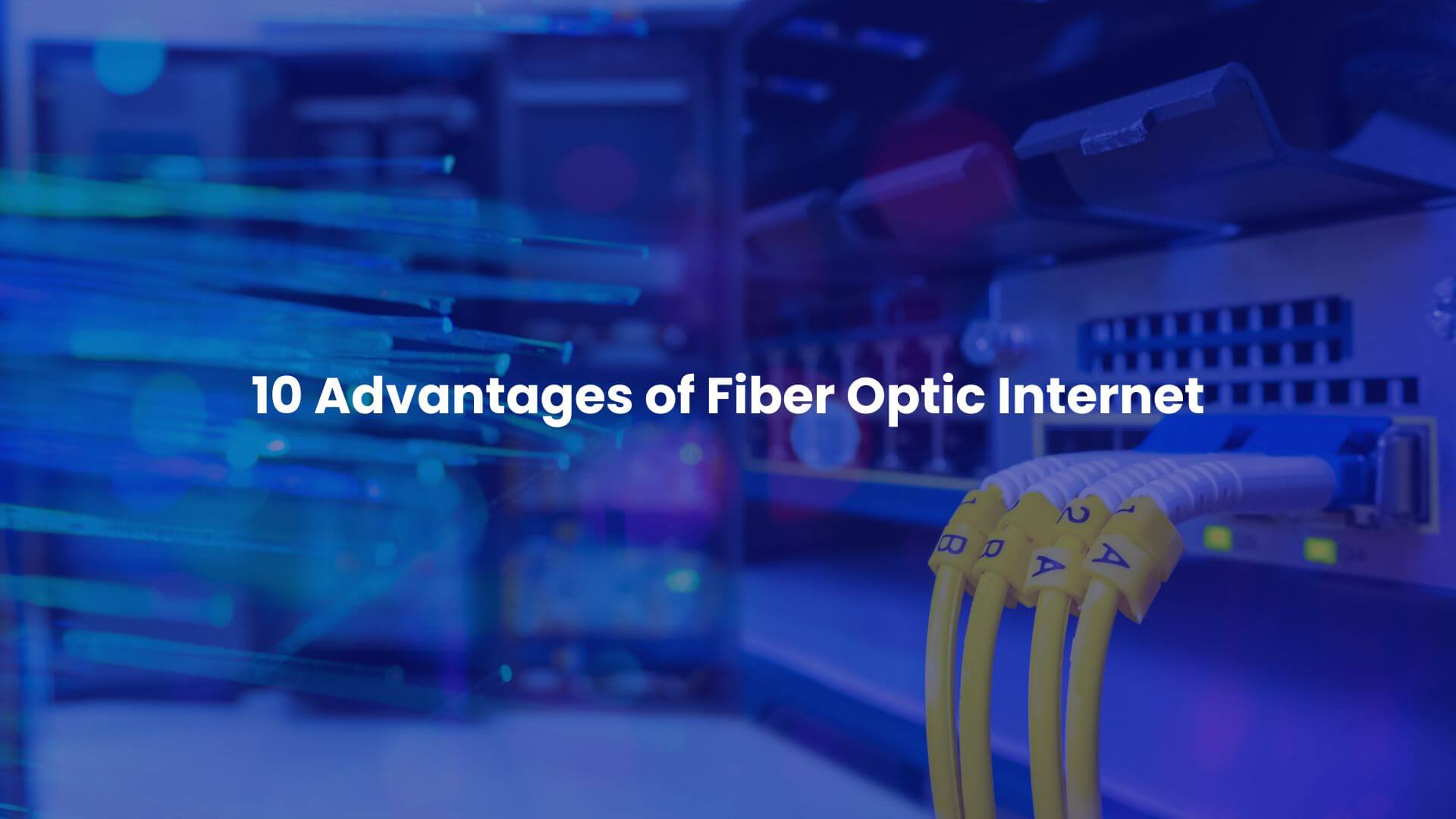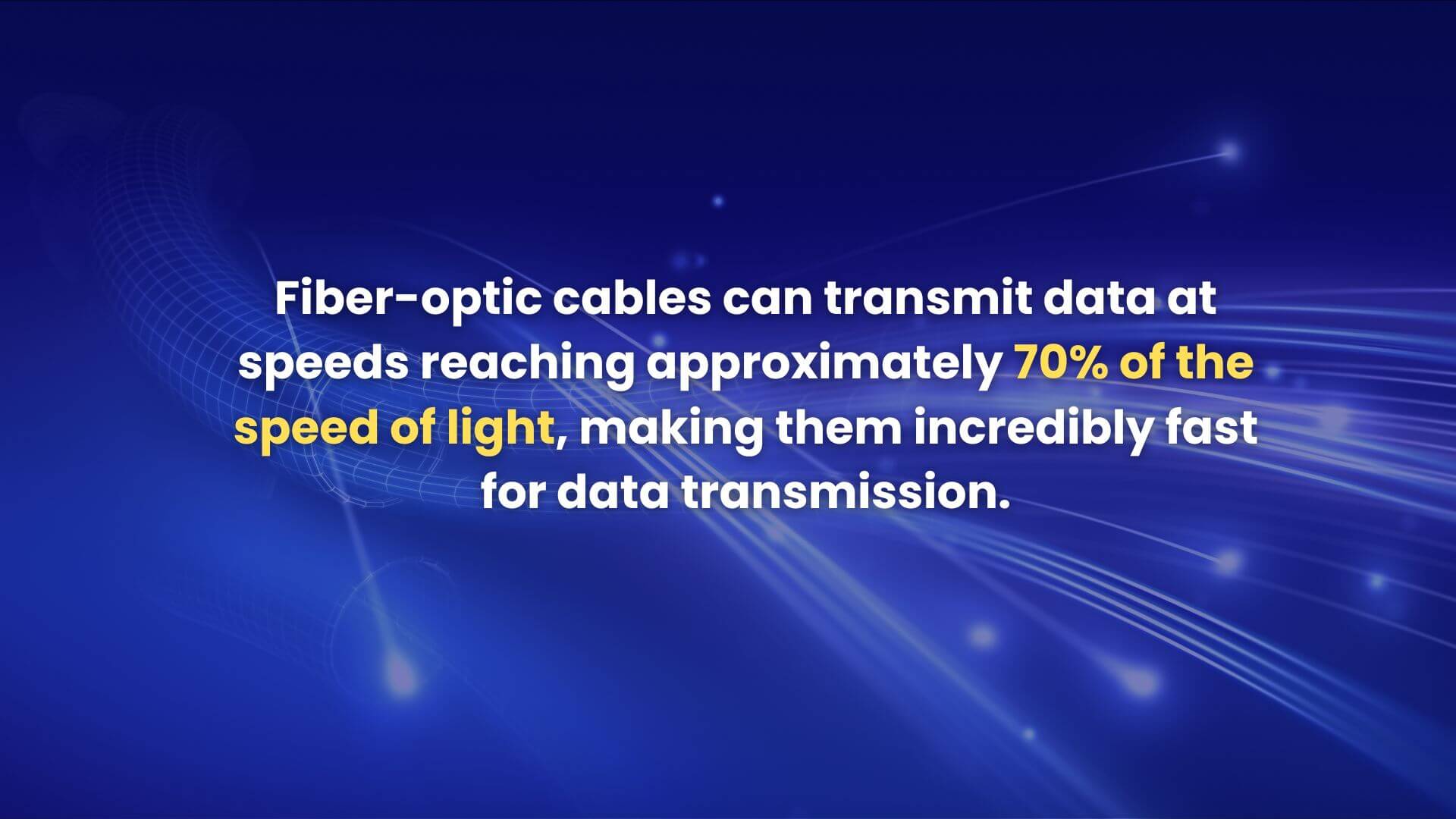Fiber Internet: How does it work?
Contents
What is Fiber Internet?
Fiber-optic internet, known as fiber, achieves speeds up to 10 Gbps using light signals through fiber-optic cables, delivering robust connectivity. It’s less affected by weather, ensuring minimal outages and resisting electrical interference.
Fiber Internet: How It Works
Fiber internet works by using thin glass or plastic strands (fibers) to transmit data as pulses of light. These light signals travel through the fibers, bouncing off the inner walls, and reaching the destination. This transmission happens at incredible speeds, as fast as about 70% the speed of light.
Fiber-optic cables transmit data using pulses of light through glass or plastic fibers. These cables can achieve speeds that are about 70% of the speed of light, making them exceptionally fast and efficient for data transmission.
Compared to other types of internet, such as cable or DSL:
- Working Principle: Fiber internet uses light to transmit data, while cable and DSL use electrical signals over copper wires.
- Speed: Fiber provides much faster speeds, reaching up to 10 Gigabits per second (Gbps), surpassing the capabilities of cable or DSL, which typically offer lower speeds.
- Reliability: Fiber is less prone to interference and signal loss over long distances compared to copper-based connections, resulting in more reliable and consistent performance.
- Bandwidth: Fiber offers significantly higher bandwidth, allowing for faster upload and download speeds simultaneously, unlike some other connections that may have slower upload speeds.
- Resistance: Fiber cables are more resistant to weather conditions and external interference, ensuring a more stable connection compared to traditional copper-based cables.
Introduction to Fiber Evolution:
Start of Fiber: In the 1970s, engineers developed early fiber technology. They discovered that light could travel along a fiber’s length by bouncing off its inner walls. However, these early fibers had limitations.
Step 1 – Basic Fiber: The first type of fiber had a core (center) with slower light speed than the outer region (cladding). This difference allowed light to stay in the core by reflection, similar to how we see the sky’s reflection on a lake’s surface.
Step 2 – Improvements: Engineers developed a more complex fiber (step index) with two glass compositions to improve performance. However, making these fibers accurately was challenging.
Step 3 – Gradual Improvement: To address fragility issues, scientists altered the core’s composition, adding multiple glasses. This reduced fragility but still had limitations in data transmission distances.
Step 4 – Bandwidth Boost: To achieve higher transmission rates, they introduced laser-optimized (LO) fibers, enabling better transmission distance and bandwidth.
Step 5 – Overcoming Limits: Engineers invented ways to transmit higher rates (like 40 or 100 Gbits/sec) over single fibers. They used multiple wavelengths and techniques like parallel transmission to achieve this, minimizing the need for additional cables.
Summary: Over time, engineers continually improved fiber technology to meet increasing demand for higher bandwidth. These advancements made fiber faster, more reliable, and capable of carrying more data over longer distances.
10 Advantages of Fiber Optic Internet

- Speedy Downloads: Fiber optic internet reaches 1 Gbps, which is up to 20 times faster than typical cable internet speeds. For instance, it takes just 40 seconds to download a 2-hour HD movie.
- Reliability: Unlike cable internet, fiber optics handle peak usage without slowdowns. They’re less prone to outages, keeping you connected even during power cuts.
- No Throttling: Cable internet often slows down during peak times, but fiber doesn’t throttle. It’s less likely to be affected by heavy usage.
- Equal Speeds: While cable internet has slower upload speeds, it offers the same high speed for both uploads and downloads.
- Better TV Streaming: With fiber optic internet, streaming 4K quality content is smooth, even at lower speeds like 500 Mbps, which may struggle on cable.
- Enhanced Gaming: Fiber’s consistent data flow provides smoother gameplay without interruptions, perfect for online gaming.
- Health Considerations: Fiber optics may be healthier as they transmit signals through cables, avoiding potential health concerns related to wireless signals like 5G.
- Multi-Device Connectivity: Fiber internet supports multiple devices simultaneously, maintaining steady, high-quality connections.
- Improved Safety: It aids in creating a more robust national network for public safety, benefiting first responders and ensuring reliable emergency services.
- Telemedicine Benefits: Faster fiber internet speeds enable higher-resolution video chats, improving telemedicine services and making healthcare more accessible remotely.
Is fiber internet faster?
In the quest for blazing-fast internet, fiber optic technology stands tall, offering speeds that leave traditional options in the dust. Wondering if fiber internet is faster? Absolutely. Here’s why:

Speed Galore:
Fiber optic internet boasts lightning-quick speeds, hitting up to 1 Gbps or beyond. Compare that to the 50-100 Mbps of cable connections or the modest 25 Mbps of DSL. Picture downloading a 2-hour HD movie: fiber gets it done in a mere 40 seconds, while cable takes about 7 minutes and DSL nearly half an hour.
Reliability Redefined:
Ever had your movie night disrupted by a buffering screen? With fiber, those interruptions become a thing of the past. Its robust infrastructure handles high traffic without breaking a sweat, ensuring a consistently high-speed connection.
Bid Farewell to Throttling:
One of the perks of fiber optic internet? No throttling. While cable connections might slow down during peak times, fiber remains unaffected, delivering consistent speeds whether it’s peak usage hours or not.
Upload and Download Parity:
Unlike cable or DSL, where upload speeds lag far behind downloads, fiber treats them equally. This symmetry is a game-changer for sharing large files or working from home.
Future-Proofed Connectivity:
As technology advances and demands soar, fiber internet positions itself as the future-ready solution. It seamlessly accommodates the increasing need for speed and bandwidth, ensuring you won’t be left in the slow lane.
Absolutely. Its speed, reliability, and future potential make it a clear winner in the high-speed internet game. If speed is what you seek, fiber optic is the road to take.
